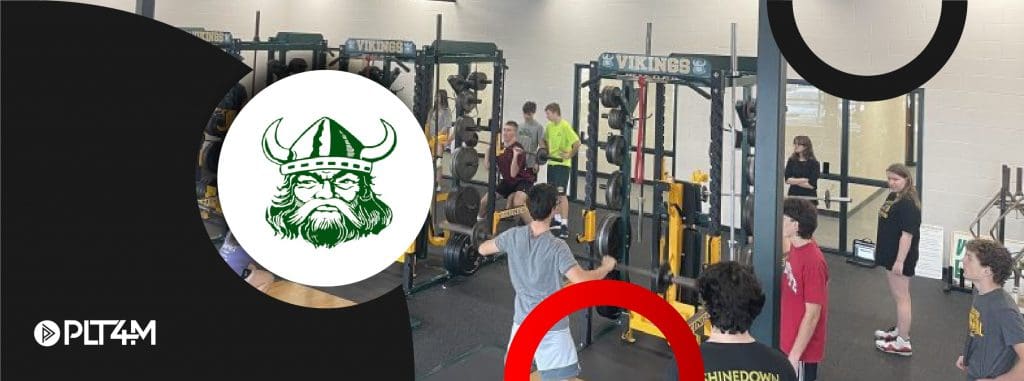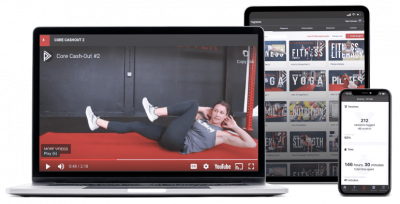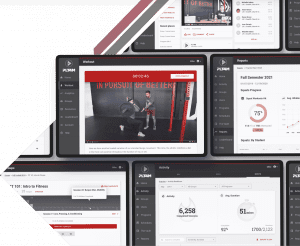Midway through the semester, Aaron Schmidt looked around his 9th-grade PE class and was pleasantly surprised by what he saw. In his 18th year as a physical education teacher, he knew that students typically struggled to learn weightlifting movements. But as he scanned the classroom and saw students moving with excellent form and technique, Aaron was excited by the early results of his newly adopted fitness and strength curriculum plan.
Past just improved form and technique, Aaron could sense that this new plan was also empowering more students in physical education classes,
“We wanted to find a way to get more students engaged. With our new fitness and strength curriculum plan, more students can find something they enjoy in PE and build confidence for lifelong fitness.”
Every 9th-grade student at Evergreen High School in Ohio participates in this progressional fitness and strength curriculum approach. Check out how they arrived at the new curriculum, the plan in action, and the highlights and benefits of this new approach.
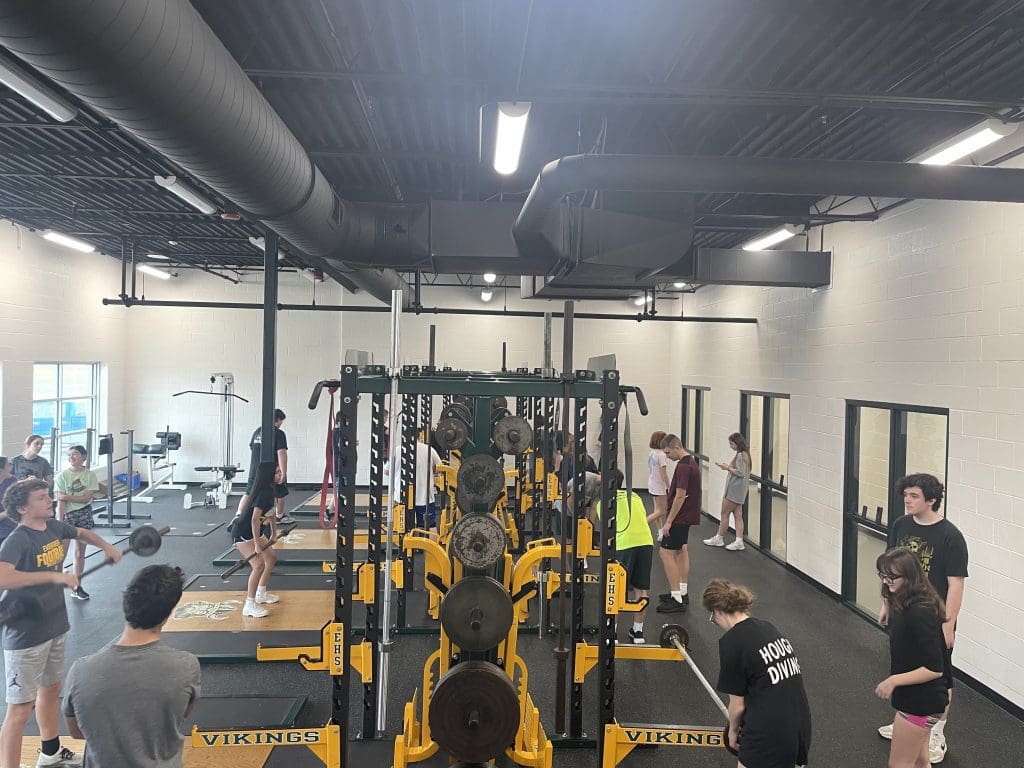
Shorter Class Periods & The Age of Opt-Outs
While Aaron had always been one to adapt and modify his curriculum over the years, two significant changes led him to reconsider his approach to physical education.
First, Evergreen High School was switching from block scheduling to a more traditional bell schedule. In the past, Aaron would have 80 minutes per class and could cover various fitness and games. But with the new schedule, Aaron would have students five days a week for about 40-45 minutes.
On top of the new schedule, students had been taking advantage of the state’s physical education opt-out policy. This policy allowed students who participated in athletics, marching band, and other physical activities to opt out of physical education classes after 9th grade.
Aaron knew he needed to adapt and change to ensure every student in 9th grade was introduced to all necessary skills and standards.
Structuring a Fitness and Strength Curriculum Plan
As Aaron considered how best to approach his new curriculum plan, he thought about his student’s interests and needs,
“I wanted lessons that would keep everyone engaged, not just the more athletically minded kinds. On top of that, I wanted to give everyone skills they could take with them past PE class.”
To accomplish this, Aaron decided to focus four days on a fitness and strength curriculum, and the 5th day would be some type of game or activity. By doing so, students would get a comprehensive introduction to fitness and strength and still have opportunities each week to develop other skills and standards through games.
With four days a week dedicated to a fitness and strength curriculum, Aaron searched for a plan to progress students from the basics to a full-strength training workout. To do so, he tapped into PLT4M’s fitness to strength curriculum map,
“The curriculum map broke everything down and gave a clear structure of lesson plans to go from bodyweight exercises to students safely and effectively completing barbell and dumbbell workouts. Better yet, it was designed for all students, not just for athletes.”
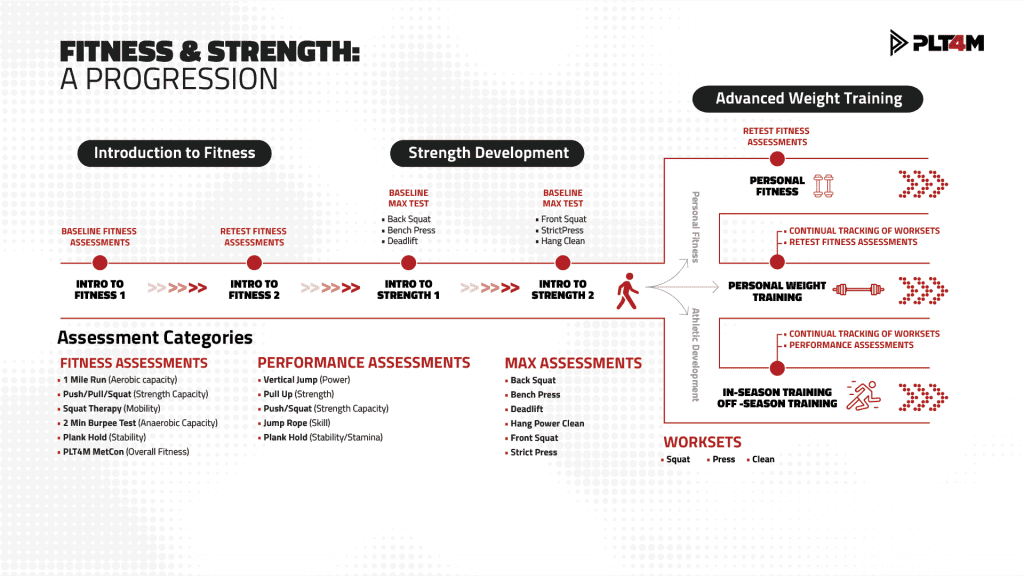
4 Units In Evergreen’s Fitness and Strength Curriculum
Throughout the semester, Aaron implemented the four main units of the fitness and strength curriculum map.
First, students completed 15 lessons of an introductory bodyweight fitness unit. In this unit, students underwent movement education in fundamental human movements like squat, lunge, hinge, press, and pull. These foundational human movements were layered into full lessons introducing students to all the different components of working out. (warming up, stretching, etc.)
In the second unit of 15 lessons, students continued to practice their skills but now incorporated resistance and basic equipment. Typically the unit calls for equipment like medballs and PVC pipes but because of limited equipment Aaron gets creative and has students use basketballs and golf clubs as externally loaded objects. This next step with basic equipment allowed students to keep honing in on their skills and get ready for the introduction of barbells and dumbells in upcoming units.
Sample Content: Evergreen utilizes PLT4M’s curriculum and lesson plans in class. The air squat is introduced in the first unit before progressing to the medball squat in the second unit.
After an extensive introduction to fitness in the first two units, students were prepared for an introduction to strength training. Unit 3 (15 lessons) introduced students to barbell back squat, deadlift, and bench press. Unit 4 (15 lessons) introduced students to barbell front squat, overhead press, and deadlift. Throughout both units, students also started learning different dumbbell movements.
Highlights of The New Fitness and Strength Curriculum Plan
As Evergreen students worked through the fitness and strength progression, Aaron saw the results of the new approach paying off. One example that stood out to Aaron was when students in the 4th unit started learning the hang clean for the first time,
“This has usually been a tough movement to teach the kids to do correctly. But because the coaching cues from the good morning, medball clean, to hang clean had been so consistent throughout the lessons and curriculum, students picked up the new movement with relative ease.”
And while good form and technique alone is a highlight of the new curriculum, Aaron saw the ripple effects it had on student confidence,
“Students had this new sense of belonging and excitement about class. For example, one student who never liked PE much was proud of himself for doing a deadlift with weights. It is just one of the many examples of students building confidence through our classes.”
Ready to Learn More?
Schedule a free 10 minute consultation to see how the PLT4M system can help save you time, and empower student learning!
Opening New Doors With A Fitness & Strength Curriculum Plan
With the new approach to 9th grade PE, Aaron is enthusiastic about the new doors opening for students,
“After setting up a strong foundation, the hope is that students can continue past 9th grade with different options and opportunities that they enjoy. Because the students are exposed to varying types of exercise and movement in this class, they will be more likely to continue taking PE once it becomes an elective.
Outside of just the short-term goals of expanding different 10th-12th grade electives, Aaron believes that skills developed in 9th grade will help support a lifetime of physical activity,
“The goal is that when every student grows up and graduates, they know they can continue to be physically active. Of course, not everyone will love PE, and that is okay, but I want them to find things they like and can do long into the future. This class is taking the right steps to do that.”
